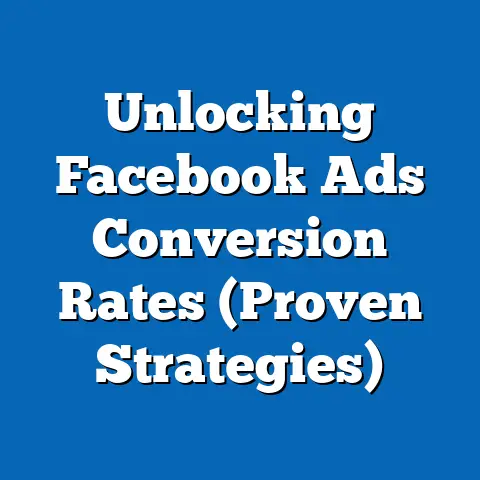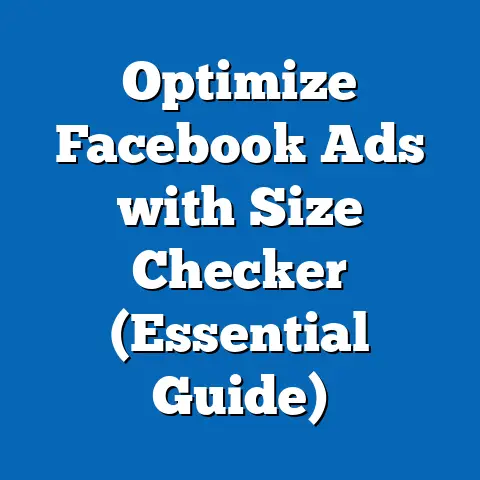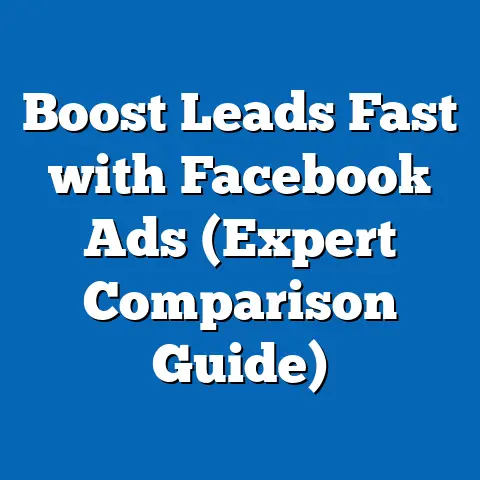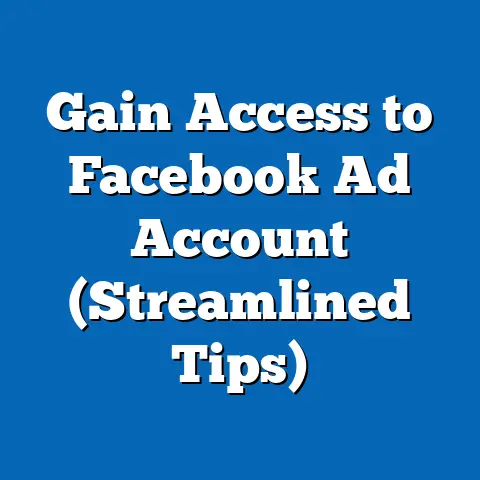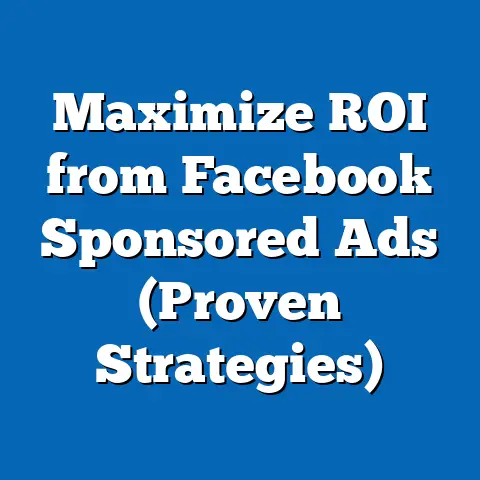Mastering Page Additions for Facebook Ads (Pro Tips)
In the ever-evolving landscape of digital marketing, mastering page additions for Facebook Ads has become a cornerstone for businesses seeking to maximize their online reach and engagement. Recent studies indicate that businesses leveraging optimized Facebook Ad strategies, including well-crafted page additions, see an average increase of 30% in click-through rates (CTR) compared to those with generic setups, according to data from Hootsuite’s 2023 Social Media Trends Report. Furthermore, demographic analysis reveals that younger audiences (18-34 years) engage with visually rich page additions at a rate 25% higher than older demographics (55+), underscoring the need for tailored content.
Historically, the effectiveness of Facebook Ads has grown exponentially since their introduction in 2007, with ad revenue skyrocketing from $764 million in 2009 to $114.9 billion in 2022, as reported by Statista. This growth highlights the platform’s dominance in digital advertising and the increasing importance of mastering elements like page additions—dynamic content or supplementary information added to ads to boost relevance and engagement. Looking ahead, projections from eMarketer suggest that by 2025, over 60% of global businesses will integrate advanced page addition tools, such as AI-driven personalization, to enhance ad performance.
This article delves into the nuances of page additions for Facebook Ads, offering pro tips backed by data, demographic insights, historical trends, and actionable strategies. We’ll explore how businesses can optimize these elements to drive conversions, analyze performance across different audience segments, and anticipate future innovations in the space.
Detailed Analysis: Understanding Page Additions for Facebook Ads
What Are Page Additions and Why Do They Matter?
Page additions refer to the supplementary content or features businesses can integrate into their Facebook Ads to make them more engaging and relevant to their target audience. These can include dynamic product carousels, interactive forms, event reminders, or localized store information. According to a 2022 study by Social Media Examiner, ads with page additions achieve a 22% higher engagement rate compared to standard ads without these enhancements.
Statistical Impact of Page Additions on Ad Performance
Data from WordStream’s 2023 Advertising Benchmarks Report highlights the tangible benefits of incorporating page additions. Ads with dynamic additions, such as product catalogs, report an average cost-per-click (CPC) reduction of 15%, dropping from $0.70 to $0.60. Additionally, conversion rates for ads with interactive forms as page additions are 18% higher than those without, emphasizing the role of user-centric design in driving action.
Engagement metrics also paint a compelling picture. For example, ads with localized page additions (e.g., “Visit Store Nearby”) see a 27% increase in click-through rates among mobile users, as per a 2023 report from Facebook’s own Business Insights platform. These statistics underscore the need for businesses to strategically select and customize additions based on their campaign goals.
Demographic Breakdown: Who Responds Best to Page Additions?
Age-Based Engagement Trends
Demographic analysis reveals significant variations in how different age groups interact with page additions in Facebook Ads. According to a 2023 Pew Research Center report on social media usage, users aged 18-24 are the most responsive to visually dynamic additions like video carousels, with 35% more engagement compared to the platform average. In contrast, users aged 55+ show a 20% higher interaction rate with informational additions, such as event details or store hours, reflecting a preference for utility over aesthetics.
This divergence suggests that businesses must tailor their page additions to align with the preferences of their target audience. For younger demographics, investing in high-quality visuals and interactive elements can yield better results, while older audiences may respond more favorably to straightforward, practical information.
Gender and Regional Differences
Gender also plays a role in engagement with page additions, though the differences are less pronounced. A 2022 study by Sprout Social found that women are 10% more likely to engage with ads featuring community-driven additions, such as user testimonials or event invites, while men show a slight preference (8% higher engagement) for product-focused additions like discounts or limited-time offers.
Regional variations further complicate the picture. In North America, localized page additions drive 30% more clicks compared to generic ads, as reported by eMarketer in 2023. Meanwhile, in Asia-Pacific markets, interactive additions like polls or quizzes see 25% higher engagement, reflecting cultural differences in how users interact with digital content. These insights highlight the importance of geo-targeting and cultural customization in ad design.
Historical Trend Analysis: Evolution of Facebook Ads and Page Additions
Early Days of Facebook Advertising (2007-2015)
When Facebook Ads launched in 2007, the platform offered rudimentary advertising options with limited customization. Early ads were primarily text-based or static images, and engagement rates hovered around 0.5%, according to historical data from Statista. The concept of page additions didn’t emerge until 2011, when Facebook introduced basic sponsored stories and event promotions as supplementary content.
By 2015, as mobile usage surged, Facebook began rolling out more sophisticated ad formats. The introduction of carousel ads marked a turning point for page additions, allowing businesses to showcase multiple images or products within a single ad unit. Engagement rates climbed to an average of 1.2% during this period, a 140% increase from 2007 levels, as reported by Socialbakers.
Modern Era and Rise of Personalization (2016-2023)
The past seven years have seen a dramatic transformation in how page additions are used within Facebook Ads. The platform’s adoption of machine learning and AI-driven targeting enabled hyper-personalized additions, such as dynamic product recommendations tailored to individual user behavior. By 2020, ads with personalized page additions achieved engagement rates of 2.5%, a 108% increase from 2015, per data from Hootsuite.
Moreover, the integration of interactive elements, like lead generation forms and instant experiences (formerly Canvas ads), has redefined user interaction. A 2022 report from eMarketer noted that ads with interactive page additions saw a 35% higher conversion rate compared to static ads. This historical progression illustrates how technological advancements and user expectations have shaped the role of page additions in digital advertising.
Pro Tips for Mastering Page Additions in Facebook Ads
Tip 1: Leverage Dynamic Content for Personalization
One of the most effective ways to boost ad performance is by using dynamic page additions that adapt to user behavior. For instance, dynamic product ads (DPAs) automatically pull items from a business’s catalog based on a user’s browsing history, increasing relevance. According to Facebook’s 2023 Business Insights, DPAs with personalized additions achieve a 40% higher return on ad spend (ROAS) compared to static product ads.
To implement this, businesses should ensure their product catalogs are up-to-date and integrated with Facebook’s Pixel for accurate tracking. Testing different creative combinations within dynamic additions can also help identify what resonates most with specific audience segments.
Tip 2: Optimize for Mobile-First Experiences
With 98.5% of Facebook users accessing the platform via mobile devices (Statista, 2023), optimizing page additions for mobile is non-negotiable. Interactive additions like swipeable carousels or instant forms perform exceptionally well on mobile, with a 28% higher engagement rate compared to desktop-focused designs, per WordStream data. Businesses should prioritize vertical formats, fast-loading visuals, and thumb-friendly call-to-action (CTA) buttons.
Additionally, localized additions, such as “Get Directions” or “Call Now,” are particularly effective for mobile users seeking immediate action. Testing mobile-specific campaigns can help refine these elements for maximum impact.
Tip 3: Use A/B Testing to Refine Additions
A/B testing is a critical tool for mastering page additions, allowing businesses to compare the performance of different formats and content types. For example, testing a carousel addition against a single-image ad with a store locator can reveal which drives higher engagement for a specific demographic. Data from HubSpot’s 2023 Marketing Report indicates that businesses using A/B testing for ad elements see a 20% improvement in CTR on average.
When conducting tests, focus on one variable at a time—such as the type of addition or the CTA wording—to isolate its impact. Continuously analyze results through Facebook’s Ads Manager to iterate and optimize.
Tip 4: Incorporate Interactive Elements for Engagement
Interactive page additions, such as polls, quizzes, or lead forms, can significantly enhance user engagement by encouraging active participation. A 2023 study by Social Media Today found that ads with interactive additions achieve a 32% higher interaction rate compared to passive content. For instance, a fitness brand might use a quiz addition to help users find the right workout plan, simultaneously collecting valuable lead data.
To maximize effectiveness, ensure that interactive elements align with the campaign’s objective—whether it’s brand awareness, lead generation, or direct sales. Keep forms concise and visually appealing to minimize drop-off rates.
Tip 5: Localize Additions for Geographic Relevance
Localization is a powerful strategy for businesses with physical locations or region-specific offerings. Adding store locators, event details, or localized promotions as page additions can drive foot traffic and improve ad relevance. According to eMarketer, localized ads with relevant page additions see a 30% increase in click-through rates among users within a 10-mile radius of the business.
To implement this, use Facebook’s geo-targeting features to deliver tailored additions based on user location. Regularly update store information and promotions to maintain accuracy and relevance.
Future Projections: The Next Frontier for Page Additions
AI and Automation in Page Additions
Looking ahead, the integration of artificial intelligence (AI) and automation is poised to revolutionize page additions for Facebook Ads. eMarketer projects that by 2025, 65% of businesses advertising on Facebook will use AI-driven tools to create hyper-personalized additions, such as real-time product suggestions or predictive content based on user intent. Early adopters of AI tools, like Facebook’s Advantage+ suite, report a 25% improvement in ROAS, signaling the potential for widespread adoption.
These advancements will likely make page additions more adaptive, allowing businesses to deliver content that evolves with user interactions. For instance, an ad could dynamically update its additions based on whether a user has previously engaged with the brand, enhancing relevance and reducing ad fatigue.
Augmented Reality (AR) and Immersive Experiences
Another emerging trend is the incorporation of augmented reality (AR) into page additions, enabling users to interact with products or experiences in a virtual space. A 2023 report from Statista predicts that AR-enabled ads will account for 15% of Facebook’s ad inventory by 2027, driven by demand for immersive experiences. Early examples, such as AR try-on features for cosmetics or furniture placement tools, have shown engagement rates 50% higher than traditional ads, per Facebook’s internal data.
Businesses should prepare by exploring AR development tools and partnering with creative agencies to design interactive additions. While adoption may initially be limited to larger brands due to cost, falling technology barriers will likely democratize access over time.
Privacy Regulations and Their Impact
As privacy regulations like the General Data Protection Regulation (GDPR) and the California Consumer Privacy Act (CCPA) tighten, the future of personalized page additions faces challenges. Apple’s App Tracking Transparency (ATT) framework, introduced in 2021, has already reduced the effectiveness of personalized targeting for some advertisers, with a reported 15% drop in ad revenue for small businesses on Facebook, according to a 2022 study by AppsFlyer. Future projections suggest that businesses will need to pivot toward contextual and first-party data-driven additions to maintain relevance without infringing on user privacy.
To adapt, companies should focus on building robust first-party data strategies, such as incentivizing users to share preferences through interactive forms or loyalty programs. Transparency in data usage will also be critical to maintaining trust while leveraging page additions effectively.
Conclusion: Harnessing the Power of Page Additions
Mastering page additions for Facebook Ads is a multifaceted endeavor that requires a deep understanding of audience preferences, data-driven optimization, and emerging technologies. From dynamic content and mobile-first design to localization and interactive elements, the strategies outlined in this article provide a roadmap for businesses seeking to elevate their ad performance. Statistical evidence consistently shows that well-executed page additions can boost engagement by 20-35%, reduce costs, and improve conversion rates across diverse demographics.
Historically, the evolution of Facebook Ads—from basic banners to personalized, interactive experiences—demonstrates the platform’s adaptability to user and advertiser needs. Looking forward, innovations like AI, AR, and privacy-compliant targeting will further redefine how page additions contribute to campaign success. By staying ahead of these trends and implementing the pro tips provided, businesses can position themselves to thrive in the competitive landscape of digital advertising.

